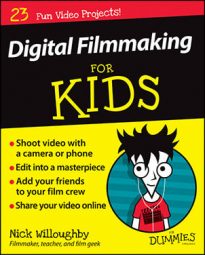Have you ever thought about why your favorite film is your favorite film? Is it the actors? Is it the special effects? Or is it the story? A good story is made up of a beginning, middle, and end. This is also known as a three‐act structure. Without these three sections, the audience may feel confused or as if they have missed something.
Before writing a story, you need to develop the idea. If you’re short of ideas, consider using the idea you created for your trailer as the basis for your film.
When developing your idea, decide on a genre for your film, then think about what your audience would want to see. Is there an existing story you can base your idea on? Think about what’s possible to film with the resources, actors, and locations you have. Remember to write down all your ideas — and keep in mind, no idea is a bad idea.
When you write a story for a film, you may want to begin by dividing your idea into a beginning, middle, and end. This will helps you to structure the story and work out if something is missing or doesn’t work.
Act I: The Setup
This is where you set up your story, characters, and genre, revealing any background information or character history that’s essential to the story. You don’t have to jump straight in to introducing your characters at the beginning of Act I, but it should be done at some point in the first act. It’s important to keep this section engaging as your audience could turn away if nothing happens.
You may want to build up to the main event and confrontation. Act I in one crew’s film includes the children meeting in the forest and introducing the characters and setting. This crew builds up to the main event with the children finding themselves lost. At this point, the audience has no idea what is coming and about to happen to them, but the tension is building.
Act II: The Confrontation
This is normally the longest section and can be the hardest to write. This section is where you introduce the main event or the confrontation. Here, there should be a turning point in your story. Maybe your characters are in danger. Maybe there’s an unexpected twist in your story. It’s your opportunity to grab the attention of your audience or surprise them with a story twist.
In one crew’s film, Act II starts with the children in the forest discovering that someone is following them. Over the course of the act, this crew builds up the tension and panic in the characters until the unexpected twist: The characters find a time vortex in the forest, and at the same time, they meet the character that has been following them, a man from the future who turns out to be one of the children, all grown up. He explains that he wants to save the children by helping them out of the forest.
Act III: The Resolution
This is where you bring your story to an end — but remember to keep things interesting. You can always introduce another plot twist here to grab the attention of your audience. Your resolution shows how your characters deal with and overcome the conflict in Act II. This might be the most emotional part of your film.
In one crew’s film, Act III shows how the children try to get out of the forest before it gets dark. It’s a race against time, which adds emotion and tension for the audience. This crew ends their film with the children finding their way out of the forest and ultimately changing their future and saving everyone.
You don’t always have to have a happy ending. You could write an unexpected ending as long as it makes sense to your audience and won’t leave them wondering what’s just happened. It’s important to take your audience on an “emotional rollercoaster,” meaning that your story takes your audience’s emotions up and down throughout the film. If you just have lots of action all the way through, and no resting moments, your audience will feel emotionally exhausted and perhaps even bored.
Your audience will follow the emotions of your characters, so try to include a range of emotions and feelings in your story. If one moment your characters are scared because they can hear noises in the forest, and the next, they’re running because they’re being chased, and the moment after that, they’re upset because they realize they’re in danger, this will keep your audience interested and engaged.
Another way to keep your audience interested is by being unpredictable with your story. Don’t be too unpredictable or create an event or situation out of nowhere to fix a problem in your story, however, because you may confuse your audience. Still, including an unexpected twist in your story could make your film great, as long as it fits in with the rest of the story.

